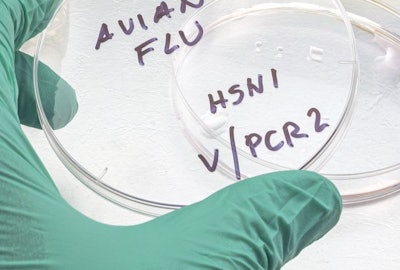
Over the past two weeks, the European Commission (EC) has harmonized the rules across the EU on the vaccination of animals against the most devastating diseases. Because of the widespread and significant damage it has caused to the region’s poultry sector, the new rules will apply to highly pathogenic avian influenza (HPAI).
For this virus, the rules have been fine-tuned to facilitate the movement of poultry and their products from premises and areas where vaccination is carried out, without adding to the risk of further virus transmission.
“In light of the most serious outbreak in recent history in the EU, the fight against avian influenza is at the top of our priorities,” said European Commissioner for Health and Food Safety Stella Kyriakides. “These outbreaks are causing enormous damage to this agricultural sector and hamper trade.”
Currently, no avian flu vaccination is permitted in the EU. However, Kyriakides said that the new rules allow for a harmonization of the use of vaccination to prevent or control the spread of the disease. Furthermore, she said, they set out the conditions that will allow the movements of both vaccinated animals and their products.
Scheduled to come into effect on March 12, the new rules are in line with international standards developed by the World Organisation for Animal Health (WOAH; formerly OIE).
While the number of new outbreaks in poultry officially registered by national veterinary authorities continues to slow down, this does not appear to be the case for wild birds. For these species, the total outbreaks across the region this year is already approaching 1,000.
Overview of HPAI situation in European poultry flocks
So far in 2023, 180 outbreaks have been reported in commercial poultry flocks. This is based on the latest update of the EC’s Animal Disease Information System (as of February 25).
One or more outbreaks have occurred in 15 countries covered by the EC since the start of the year. This includes Turkey, where a second outbreak was confirmed in late February.
Based on information supplied to the EC, France has the highest number of outbreaks (59 so far this year), followed by Poland (55). These represent increases of 14 and nine outbreaks, respectively, since the EC’s previous update dated February 12.
These two nations are followed by the Czech Republic with 18 outbreaks since the start of 2023, Germany with 13, and Hungary with 12. Each of the other countries has a total so far of no more than four outbreaks.
Over the past two weeks, Poland’s animal health agency has confirmed a further 18 outbreaks in commercial flocks with WOAH. Directly impacted have been more than 196,000 poultry.
In France, the latest outbreaks affected a total of more than 706,000 commercial poultry at 10 different locations.
According to the agriculture ministry, 312 farm outbreaks have been confirmed on mainland France since August 1 last year. Affected have been flocks in all 12 regions, and in 31 departments. Recently recording first cases for this period have been the departments of Essonne (Île de France region in northern France, near Paris) and Tarn-et-Garonne (Occitanie in the south).
Hungary’s veterinary authority has notified WOAH about seven further outbreaks in the southern county of Bacs-Kiskun. In three German states, four commercial poultry flocks have tested positive for the HPAI virus, based on the latest WOAH reports.
In both Belgium and the United Kingdom (U.K.), one more commercial premises has been affected by new cases.
Following a 12-month hiatus, HPAI has been confirmed at a farm in Slovenia.
In all these outbreaks, the presence of the H5N1 HPAI virus serotype has been confirmed.
New outbreaks recorded in captive birds
As of February 25, 10 European nations have notified the EC’s System of HPAI cases in “captive birds” since the start of 2022. Covering backyard and hobby poultry flocks as well as premises such as zoos, the total stands at 65 across the region for the year so far.
Affected since the start of January have been 24 premises in Germany, 23 in France, and six in Belgium. Each of the other seven countries has recorded no more than four outbreaks in this category.
Not covered by the EC System is the U.K. (excluding Northern Ireland). In the first half of February, cases were detected in three backyard flocks in other parts of the country. These were located in each of England, Wales, and Scotland.
Europe’s wild bird outbreaks approach 1,000
So far this year, a total of 919 outbreaks of HPAI have already been registered through the EC’s System by 22 European states (as of February 25).
These include the first case of the year in Luxembourg.
With 252 outbreaks in this category, Germany has confirmed the most outbreaks. This is 107 more than in the EC’s previous report dated February 12. France now has a total of 141 for the year, followed by Belgium (119), and Austria and the Netherlands, each with 75. Each of the other countries reporting outbreaks has a total of between one and 48 outbreaks so far this year.
View our continuing coverage of the global avian influenza situation.

















